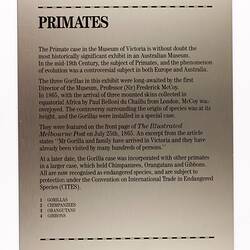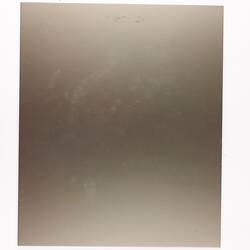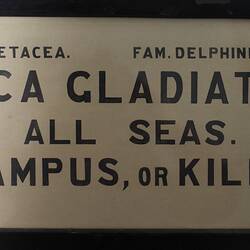Summary
Exhibition label for the Primate display at Museum of Victoria, circa 1985.
Physical Description
Rectangular label, vertical, single-sided with black printed on metal sheet. Upper and lower case TNR font with top and bottom border line. Remnants of adhesive still on back.
Significance
The labels in the Historic Exhibition Labels Collection illustrate the changing styles in didactic interpretation, aesthetics and approaches to audience engagement throughout the history of Museums Victoria. From the earliest days of the National Museum of Victoria in the mid 1800s through the various incarnations of the Applied Sciences collection through to the amalgamation of all the branches into Museums Victoria, the labels chart a course through the changes in audience needs and desires in Victoria and across the museums' various sites. There are beautiful examples of hand written nineteenth century labels, some examples of extremely long didactic panels from the early twentieth century, and rare and unusual fonts in the mid twentieth century. The collection also illustrates the transition from hand-written labels to the use of typewriters, then lettera set and ultimately printed labels, culminating in the large format digital print room being introduced at Melbourne Museum in 2000.
More Information
-
Collecting Areas
Museum History, Information & Communication, Public Life & Institutions
-
Creator
-
Inscriptions
PRIMATES / The Primate case in the Museum of Victoria is without doubt the most historically significant exhibit in an Australian Museum. In the mid-19th Century, the subject of Primates, and the phenomenon of evolution was a controversial subject in both Europe and Australia. / The three Gorillas in this exhibit were long-awaited by the first Director of the Museum, Professor (Sir) Frederick McCoy. In 1865, with the arrival of three mounted skins collected in equitorial Africa by Paul Belloni du Chaillu from London, McCoy was overjoyed. The controversy surrounding the origin of species was at its height, and the Gorillas were installed in a special case. / They were featured on the front page of the Illustrated Melbourne Post on July 25thm 1865. An except from the article states "Mr Gorilla and family have arrived in Victoria and they have already been visited by many hundreds of persons." / At a later date, the Gorilla case was incorporated with other primates in a larger case, which held Chimpanzees, Orangutans and Gibbons. All are now recognised as endangered species, and are subject to protection under the Convention on International Trade in Endangered Species (CITES). / 1 GORILLAS / 2 CHIMPANZEES / 3 ORANGUTANS / 4 GIBBONS
-
Classification
-
Category
-
Discipline
-
Type of item
-
Object Dimensions
203 mm (Width), 3 mm (Depth), 243 mm (Height)
-
Keywords
Exhibitions, Mammals, Museum Display Panels, Museum Exhibitions, Museums



